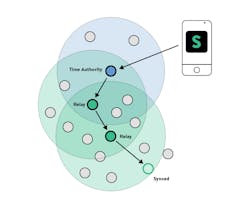Scheduling is not a new feature in wireless lighting control systems. Until recently, virtually all wireless solutions providing this functionality had one thing in common: They relied on a gateway to handle time management and to trigger desired lighting schedules. A new standard-based service can deliver on lighting schedules without a gateway device by leveraging the capabilities of the open Bluetooth mesh protocol. This article will examine the benefits of this approach and the challenges accompanying the development of the gatewayless scheduling feature.
State of the standard
Bluetooth mesh was adopted in 2017 as the first wireless standard designed specifically to address professional lighting applications. It aimed to solve the three pain points — simplicity, scalability, and reliability — while delivering innovative lighting control and data management features. A global technological shift always takes time, but Bluetooth mesh is making strong headway, with more than 1,200 qualified products on the market and projects of scale previously not achievable for standard-based wireless technologies. (See the 3,500-plus node Minneapolis project that received the 2021 Sapphire Award for Design Excellence in Networked Lighting Controls for LLLC.)
Industry organizations have also shown their support for Bluetooth mesh technology. The collaboration between the Bluetooth Special Interest Group (SIG) and the DALI Alliance continues to strengthen, and the DesignLights Consortium has certified several wireless control solutions based on Bluetooth mesh. It is still too early to consider Bluetooth mesh a go-to wireless technology for lighting controls, but the standard seems well positioned. Considering the fragmented wireless lighting control landscape over the past decade, widespread adoption would be a real breakthrough for the lighting industry. In the meantime, new Bluetooth mesh–based developments continue to advance the standard. The so- called in-node scheduling shows promise in moving the technology forward.
Essence of decentralization
The Bluetooth mesh specification included in-node time-management procedures, so gatewayless scheduling was expected on the market at some point. As a contributor to the Mesh Working Group at the Bluetooth SIG, Silvair has been working on this functionality update. In-node scheduling turned out to be a significant development effort and perhaps the most complex single feature developed as part of the company’s lighting control solutions.
Although gateway-based scheduling service was already available, we needed to implement this functionality to eliminate the gateway hardware requirement. As controls developers, we aimed to extend the scope of features available for small- and mid-sized projects where a gateway is not preferred due to, for example, internet connectivity limitations, the need to drive hardware costs down, or a preference to keep the system offline. Sometimes, a gateway device is not an option for projects that still benefit from deploying lighting schedules. Being forced to use a gateway in a lighting control system is a significantly different scenario than having an option to use a gateway in order to access additional functionalities, such as remote configuration or control.
Bluetooth mesh’s decentralized nature makes it unique among other wireless communication standards. Bluetooth mesh lighting control systems do not need a gateway or other central controller to govern the entire network, because Bluetooth mesh puts a software controller into each luminaire. The implementation of in-node scheduling fulfills the promise of decentralization with an opportunity to deliver cost-effective scheduling to projects of any scale.
Time synchronization
In-node scheduling was challenging to develop due to how a network without a central controller manages time synchronization. With gateway-based scheduling, the time-management issue is relatively straightforward. A gateway is always on and online. It can retrieve exact information on the current time from an online server whenever it is needed and share this information with the entire network; therefore, ongoing time tracking is unnecessary. If a power outage happens, the gateway simply checks the current time online when power is restored.
But things get trickier without that central controller and constant connection to time servers. For example, how will the individual nodes know the time without an internet connection? How can time desynchronization be prevented when a partial or networkwide power outage happens?
A decentralized Bluetooth mesh network addresses these issues first by defining the role of the “time authority,” or a node that keeps time for the entire network. Every individual luminaire in the topology has its own internal clock based on the user-defined scenes specified, but all these internal clocks synchronize themselves with the time authority node. This ensures that schedules are triggered simultaneously for all relevant nodes and zones.
The role of time authority is assigned automatically during the commissioning process, and it can be performed by any network node. However, priority is given to a real-time clock (RTC) node — a dedicated piece of hardware with an RTC chip and, preferably, extended battery life to keep track of the time even without an external power supply. As long as such an RTC node is available in the network, it will automatically become the network’s time keeper.
All computer systems show clock drift over time, resulting in a gradual deviation between system time and accurate or “true” time. Support for RTC hardware helps to minimize gradual time drift and ensure the precision of the scheduling service; however, an RTC node is not mandatory in a project that implements the in-node scheduling feature. In installations that include an RTC node, time drift amounts to up to 30 seconds per month. In installations without an RTC node, the potential time drift increases to approximately 120 seconds per month.
Because most RTC nodes include battery backup, they can prevent time desynchronization in the event of a networkwide power outage — and automatically share the internal clock setting with the entire network as soon as the power supply is restored.
A mobile app is the last key component of the time-management process discussed here. During the commissioning process, the app injects the current time into the network, notifying the network’s time authority of the current time (Fig. 1). Moving forward, whenever a need arises to recalibrate the time, perhaps to offset time drift or after a power outage when an RTC node is not present, a user can tap the “time sync” button.
Translating complex tech into a simple user interface
Although the underlying time-management mechanisms are technical, the user interface part of the in-node scheduling feature can be simple and intuitive. As with multiple aspects of Bluetooth mesh lighting controls, complicated network processes can be automated so the end user faces only basic decisions related to lighting control system operations.
The major steps in the scheduling configuration process are carried out off-site in the web app, which is more detailed for planning and configuration. In the case of Silvair’s app, the user specifies which lighting zones leverage the scheduling feature by assigning a predefined scheduling scenario to desired zones in floorplans (Fig. 2). Next, the user defines the lighting scenes to be triggered at desired times in accordance with the given space’s lighting needs. These can be static scenes, where the user only defines the percentage of luminaire output, or dynamic scenes that involve occupancy- or daylight-based automation. Then the user creates and names the scheduling events that will deploy these lighting scenes, entering parameters such as the day of the week and the time at which a particular event will occur.
For every lighting zone, a user can specify up to 16 time events and four scenes triggered by their defined events. This provides flexibility in terms of luminaire scheduling; for example, different schedules can be configured for different weekdays. Once the scenes and events are set up, the off-site scheduling configuration is complete. The process is finalized during the on-site commissioning phase, which is carried out via the mobile app and a smartphone or tablet. The mobile app connects with luminaires and quickly deploys the precommissioned configuration. When the app adds the installed luminaires to the network, it transfers all user-specified scheduling configuration settings to each commissioned luminaire. The app also injects the current time to the network so that its time authority node can track the time autonomously going forward. The luminaires can then start operating in accordance with the user-defined schedules.
Advanced control for everyone
By minimizing the hardware requirements for luminaire scheduling, Bluetooth mesh allows this gatewayless strategy to be implemented in virtually any lighting project, regardless of scale or budget. The goal in developing Bluetooth mesh–based systems is to provide advanced controls that can be deployed and used in every type of commercial environment to generate savings and drive energy efficiencies. Bluetooth mesh has more to offer in this regard and further developments are on the roadmap. The implementation of a standard-based, in-node scheduling feature is another milestone in accelerating worldwide adoption of advanced lighting- control strategies across many commercial enterprises.
Get to know our expert
SIMON RZADKOSZ is product marketing specialist for the wireless connectivity and controls firm Silvair, with offices in San Francisco and Krakow, Poland. He covers smart lighting, IoT, wireless technologies, and building automation.
A member of the Bluetooth Special Interest Group, Silvair offers Bluetooth mesh lighting control software that operates with partner products in the Bluetooth ecosystem.
For up-to-the-minute LED and SSL updates, why not follow us on Twitter? You’ll find curated content and commentary, as well as information on industry events, webcasts, and surveys on our LinkedIn Company Page and our Facebook page.







